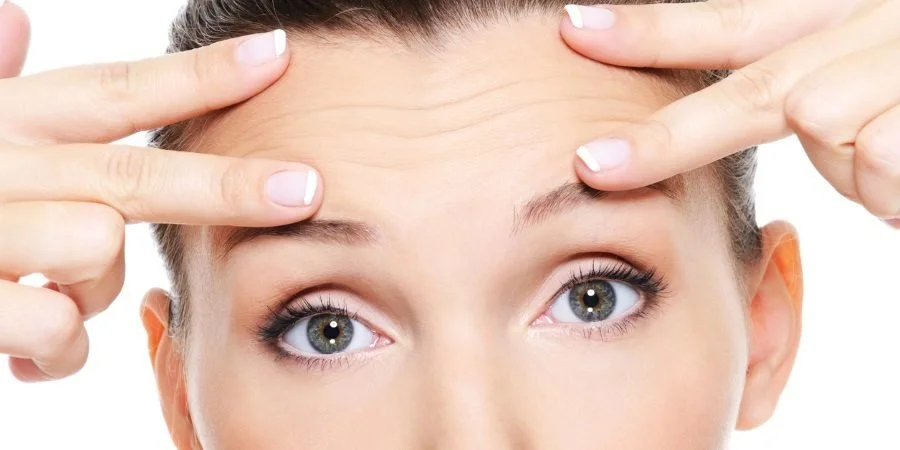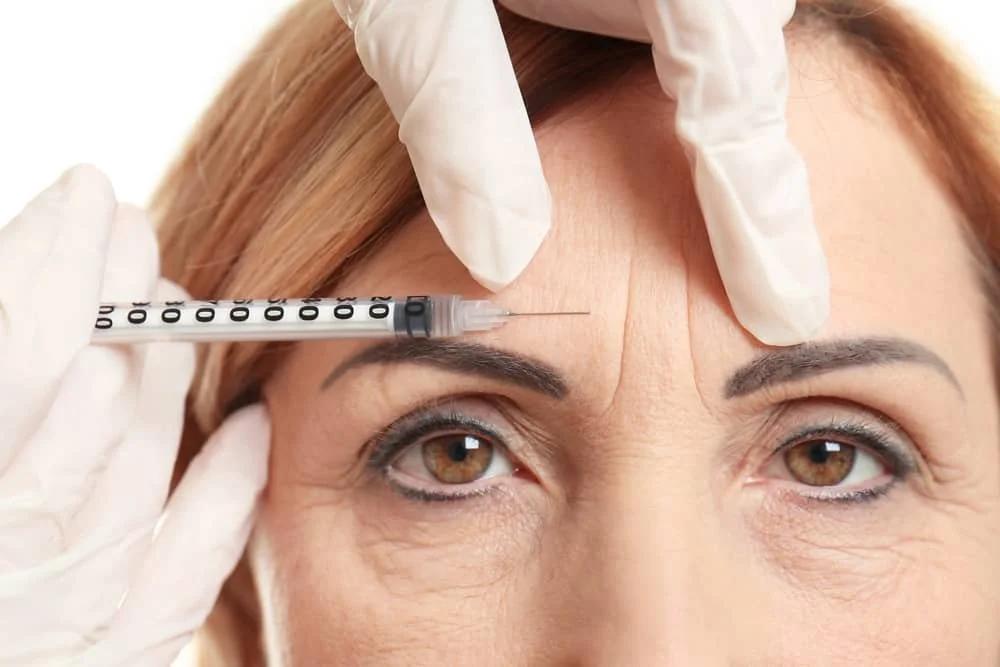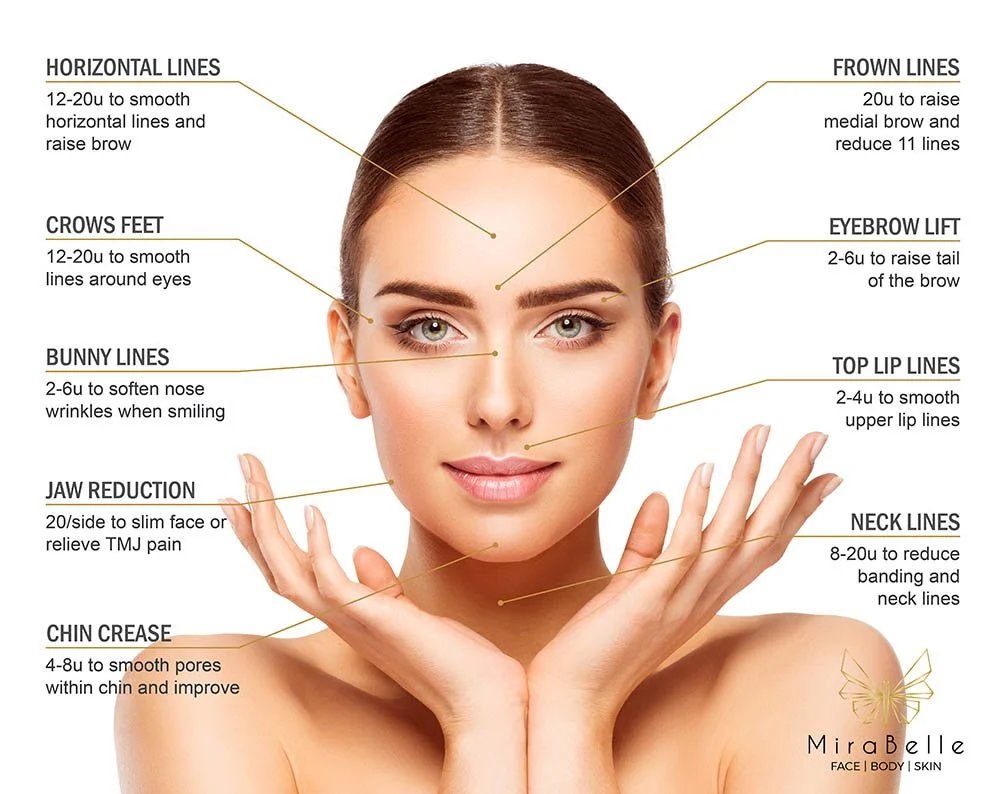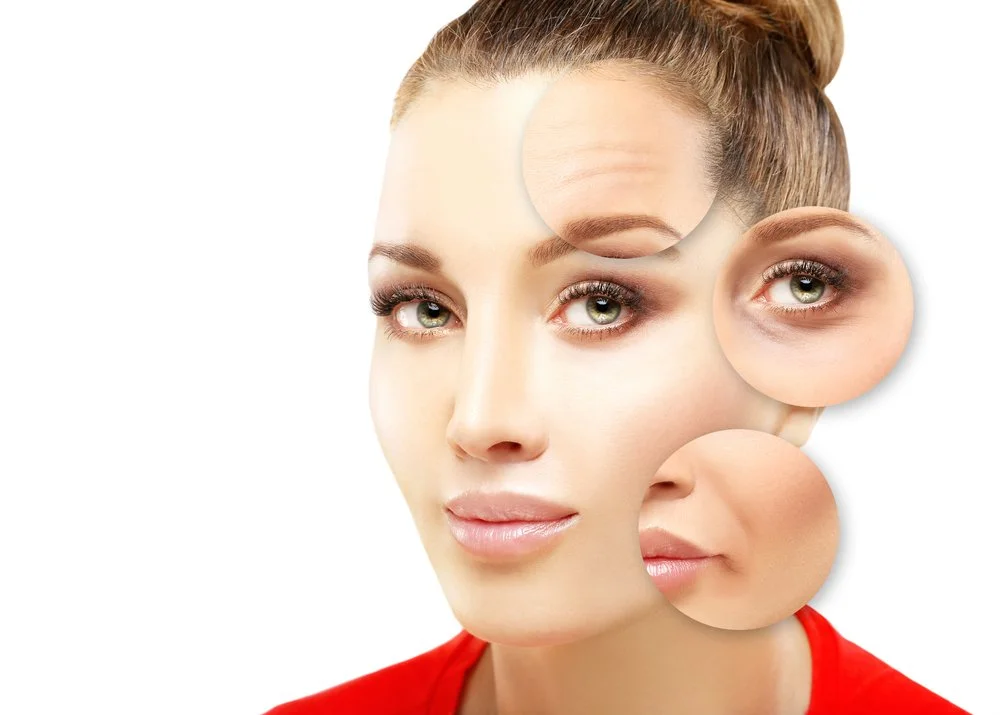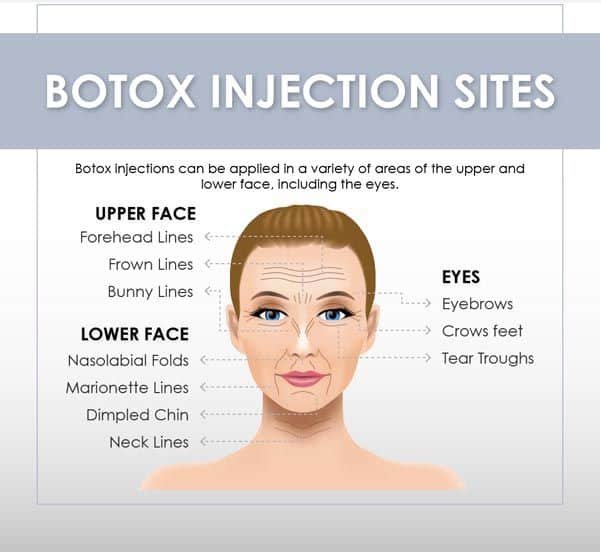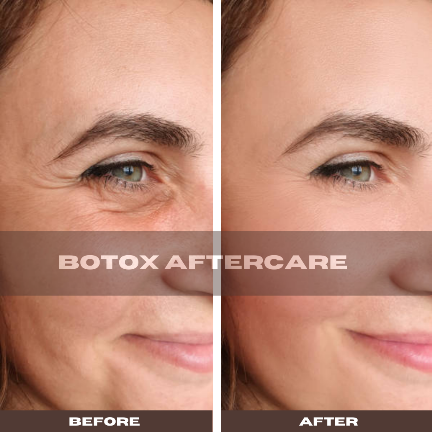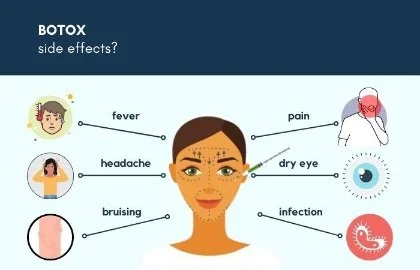What is botox?
Botox is a protein made from Botulinum toxin, which is the same toxin that causes botulism.
However, when it is used correctly and in small doses, it can have benefits for both cosmetic and medical uses. Food and Drug Administration (FDA) have approved Botox as a treatment for various health issues, including eyelid spasms, excessive sweating, some bladder disorders, and migraine.
For cosmetic treatment, Botox injections can reduce the appearance of skin wrinkles.
How it works?
Botox is a neurotoxin which target the nervous system, disrupting the nerve signaling processes that stimulate muscle contraction.
In order for any muscle to contract, the nerves release a chemical messenger called acetylcholine at the junction where nerve endings meet muscle cells. Acetylcholine attaches to receptors on the muscle cells and causes the cells to contract, or shorten. The Botox injections prevent the release of acetylcholine, which stops the muscle cells from contracting and helps the muscles to become less stiff. Therefore it causes temporary muscle paralysis.
In cosmetic use, Botox is injected into particular areas to be treated, it causes paralysis of the muscles in the area. This, in turn, leads to a relaxation of the muscles and result in the improvement of the wrinkle appearance automatically.
What Are the Benefits of Botox?
The Botulinum toxin in cosmetology procedure is used to:
Smoothing wrinkles and correct skin breakouts in areas such as the forehead, between the eyebrows, around the eyes, and lips.
Facelifting effect. Botulinum therapy helps not only to smooth out expression lines and wrinkles but also to create a lifting effect, that is, “lift” the muscles that have dropped with age.
Lip correction. During injections, the muscles of the mouth are blocked – and as a result, the habit of constantly pursuing the lips disappears.
Reducing sweating. Underarms, palms, and feet are subject to increased sweating.
what to expect?
It generally takes about 3-5 days for Neurotoxins to work, however it is also common to not see your full and final results for 7-10 days. It takes this long because it takes time for the toxin to block off those nerve impulses to the muscles - It is not an immediate full result. Clients could be expecting to wait a full 2 weeks after their Botox injection, and we recommend clients to come back after 2 weeks to see if they need any more touch-up, so that we can take care of it.
How long does Botox last?
Unfortunately, Botox doesn't last forever. Eventually, the action of the neurotoxin will wear off and the nerves will be able to send those signals to the muscles to start working or contracting again.
In general, Botox lasts 3-4 months. However there are some certain cases in which it lasts longer — in 4-6-month range, or also in some cases it could be shorter, in 2-month range. It is also common for first-timers to notice that it may not last as long initially, but may last longer after the second treatment. Everyone has a unique experience, so the results could be vary.
common treatment
areas
of the face
- Frown lines — between the eyebrows
- Crow’s feet — wrinkles around the eyes
- Horizontal creases in the forehead
- lines at the corners of the mouth
- Cobblestone — the skin on the chin
What product
do we use?
We use one of the top 4 best botox products in 2022 — ‘XEOMIN’
About the product:
Xeomin is a German-made rejuvenating agent from Merz Pharmaceuticals. It has been produced and actively used by cosmetologists since 2008. Due to its effectiveness, it is widely used throughout the world.
Among the advantages of “Xeomin” is its unique purity, which is achieved through a special purification process. This excludes the presence of protein compounds in its composition. As a consequence, the drug ensures the absence of negative reactions – including serious allergies and gives good sensitivity when working with tissues. Most cosmetologists recommend using Xeomin for the first use of botulinum toxin drugs. The effect lasts for 3-6 months.
The advantages of Xeomin also include
Local action, without affecting neighboring tissues. When the component is injected, only the desired muscle is blocked, which does not affect facial expressions.
The effect of “rejuvenation” comes quickly – on the second or third day. This excludes a long rehabilitation period.
Xeomin” may be combined in combined procedures – for example, it may be injections and mesotherapy. The components do not react with each other, do not reduce the effect, but improve the visual result.
Pre-treatment
What to prepare before your appointment
Botox treatment is a minimally invasive procedure. It is such a generally simple procedure that you may not require many preparations before getting the injections. However, you may practice the following.
Avoid stress: Although getting Botox is easy and quick, getting a needle in your face may work you up. To avoid any hassles, try to be as relaxed as you can before going for the procedure.
Mention your medications to your specialist: It is essential to let your professional know what medications you are taking. Medicines often have wide-ranging effects in the body and can potentially affect your Botox treatment results, or vice-versa. — It is usually advised not to take a medication like aspirin which acts as a blood thinner.
Aspirin can cause and worsen the bruising that may develop after the procedure. Drugs like this should be stopped at least a week before your appointment.
No smoking: Smoking cigarettes shortly before a Botox treatment increases the chances of bruising. You may ask your doctor how long before you can get back to the habit.
Dietary modifications: Asides from medicines, there are other things you consume that can potentially mimic the effects of blood thinners. You may be asked to stop consuming fish oil, multivitamins, ginger, or red wine from up to a week before your appointment. These foods can prevent blood from clotting and quickly worsen your bruising.
Cleanse your skin: For the best effects, cleanse your skin of dirt. Also, keep the makeup box away on the day of your procedure. Wash your face with mild cleansers or soap. Rinse with warm water and give it a good dry.
What is the treatment procedure ?
Botox treatment is non-invasive, so the procedure is quite a simple one. It happens quickly, so you may be ready to go in around 30 minutes.
Generally, the anesthesia is not necessary. However, because a needle will still go into your skin, our cosmetic injector may apply a topical anesthetic (numbing cream) for your comfort, which could lead to a longer procedure time.
The botulinum toxin is usually in powdered form and is dissolved using saline. After numbing skin, our cosmetic injector will use a fine needle to withdraw the toxin from the vial, then inject it into specific muscles of your face, depending on your intended results. You may feel a little sting, but it’s generally over quickly. Once done, you are free to go.
The effects of Botox injection are usually not felt immediately. It may take as short as a day or as long as a week before you start to feel the effects. For most people, the full results kick in after two weeks.
You are strongly advised to avoid scrubbing or rubbing or applying pressure to the area, as this may cause the Botox to spread within your face to where it is unintended. You may experience an unwanted side effect if this happens.
Do not bend over or lie down within three to four hours of doing the procedure. This may also cause a movement of the fluid and lead to droopy eyelids or increase bruising.
We recommend doing light facial exercises post-treatment. Some possible activities you can do include squinting, smiling, or frowning repeatedly. The idea is to help the injection settle quickly into the skin. However, full-blown exercise is discouraged because it increases blood flow. The increased blood flow may move the Botox to other areas and leave the face with inadequate amounts. The muscle contraction caused by exercise is also in direct contrast to the effects you hope for.
Avoid alcohol and also significant sun exposure, as it may increase bruising.
Facial treatments can disrupt the Botox, so we suggest you posepond your next treatment until after 3-7 days.
Botox vs. filler
What are the differences?
Botox and fillers are fundamentally different things.
Botox - “freezes” the expression lines, that is, in these areas, the facial muscles stop moving. As a result, the appearance of frown lines does not progress over time and they are less noticeable. However, the wrinkle itself does not go anywhere.
Fillers have a different effect. They add volume to the injection sites. This can be as a literal filling of the wrinkle (for example, in the area between the eyebrows), and changing the contours of the face (hence the name – contour plastics). For example, you can make the cheekbones higher, and the chin – a little more pointed. As a rule, the beautician selects an individual scheme for specific problems: in some areas relaxes the muscles with Botox, in others – adds volume with fillers.
What are the possible side effects of Botox?
Botox treatments are uncomplicated, and because the injection is localized, side effects are few. Bruising is the most common side effect you may experience from Botox procedure.
Other possible side effects are:
Temporary eyelid drooping
Swelling at the injection site
Headaches
Double vision
Dry eyes
Neck pain
Allergy
